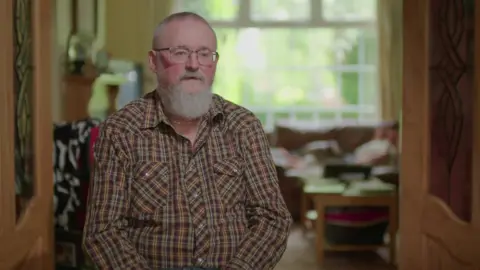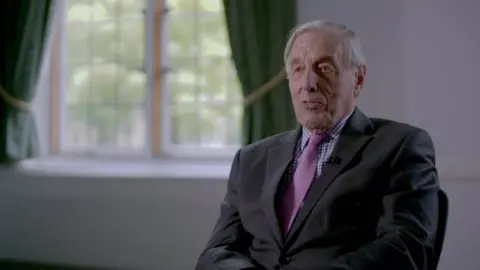The IRA executioner next door in suburbia
 BBC
BBCFreddie Scappaticci, a one-time IRA executioner and top-secret British Army agent, lived for many years under state protection in English suburbia.
The town of Guildford in Surrey is not where one might expect to find an IRA serial killer linked to multiple murders, but it's where Scappaticci settled after fleeing Belfast in 2003 following press reports about his double life.
In England, Scappaticci went under a new identity - his neighbours only knew him as Frank, and he was living under the protection of the state.
He was far from home but not from the IRA's violent legacy: In 1974, two IRA pub bombs in Guildford killed five young people.
Decades later and with Northern Ireland's peace process in place, Scappaticci's neighbours had no cause to fear the person they knew as Frank, who lived alone and was exceptionally private.
However, Scappaticci was a man of many faces.
In 2003, a BBC news crew captured his menacing side outside his home in west Belfast.
"Get yourselves off" he bellowed before explicitly warning that if they didn't leave, he would "do" them.
Scappaticci didn't follow through on that threat but he had form in brutal acts of violence alongside a fearsome IRA reputation.
"I had known Freddie Scappaticci from a young age," said Anthony McIntyre, a former IRA prisoner.
"He was a pretty ruthless character."

According to the IRA's own rules, the punishment for giving away its secrets was execution.
In 1978, Scappaticci was put on a new IRA security unit specifically tasked with flushing out spies within its ranks.
"They were responsible for basically catching informers" said Kieran Conway, a former director of intelligence for the IRA.
He said: "In retrospect it's very obvious that the British would have been rubbing their hands in glee when the unit was formed, we've just got to get into these guys and find out their weaknesses, find out everything about them and turn a couple of them."
Exactly how Scappaticci was 'turned' remains a mystery but what is known, is that by 1978, he was already working for the British Army under the code name, Stakeknife.
"Stakeknife would only talk to the Army," said Lord Ramsbotham, speaking several years before his death in 2022.
Lord Ramsbotham was an Army brigadier in Belfast from 1978 to 1980.

He continued: "The battalions never knew about Stakeknife because it wasn't their business to do so.
"I mean we didn't want to risk any compromise because what he was producing was so high grade, not necessarily useful to people on the ground, but more to the politicians and the people in headquarters Northern Ireland."
Scappaticci was not the only well-placed British Army agent within the IRA but his position gave him unrivalled IRA access.
"Scappaticci would've debriefed people after operations when they went wrong, trying to find out - supposedly trying to find out - who may have compromised the operation" explained Anthony McIntyre.
"He was then able to know who was involved in all the operations so the IRA was effectively compromised because this was sort of the Clapham Junction of the IRA."
The fate of those accused of giving away the IRA's secrets became a brutal form of public spectacle.
In a two-year period beginning May 1980, more IRA members were killed by the IRA's own internal security than by the police and Army.
Bodies of suspected informers were dumped in ditches, open ground or street alleyways.
As the 1980s ended, Scappaticci was moving in the IRA's senior circles while also being handled by a secretive unit within the British Army - the Force Research Unit, known as FRU.
But the net was closing in.
By the early 1990s the former London police chief, Sir John Stevens, was investigating how the British Army ran agents.
"FRU was an undercover team which actually worked under the direction of the GOC in Northern Ireland" said Lord Stevens. "They ran the informants on an intelligence basis. They were also handling an individual called Scappaticci on the IRA side."
In life, Scappaticci was hiding in plain sight.
After he was exposed, he lied during a now-infamous press conference when he denied that he was the agent Stakeknife.
"My statement basically is that I am Freddie Scappaticci. I am sitting here today with my solicitor. I am telling you I am not guilty of any of these allegations," he said.
Scappaticci later fled Belfast.
In England, living under his new identity, he was distant from his victims' families, accusers and collaborators.
His death, announced in April 2023, meant that agent Stakeknife was a spy who got away with murder.
Those who know the secrets he took to his grave may yet choose to share them.
Jennifer O'Leary's The Big Cases 'The Executioner Next Door' is available on iPlayer.
